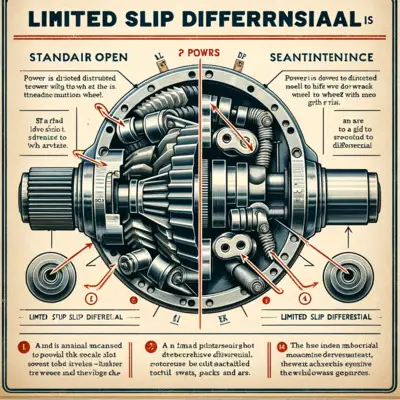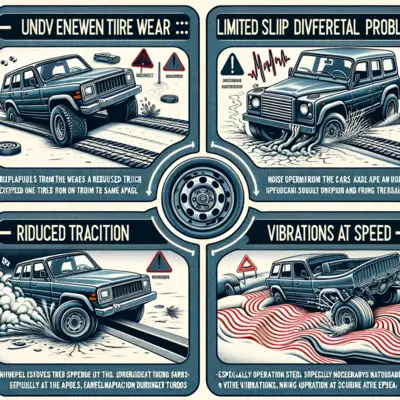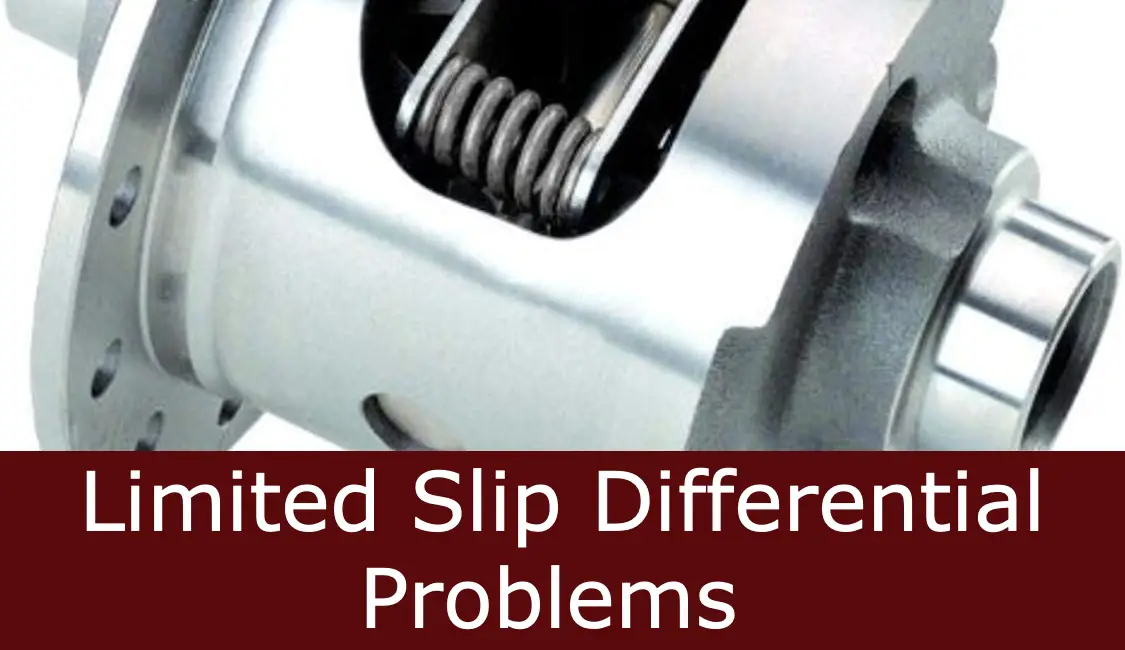Specifically, if you’re an enthusiast of sports cars as well as 4x4s, there’s a pretty good chance you could have heard about the limited-slip differential, an abbreviated term used to describe a specialized hardware piece for a drive system.
This specific component is devoted to enhancing the way a car’s engine puts its power to the pavement as well as the associated advantages that this particular device has over its rivals. However, like any other car component, limited slip differential problems are common facts.
If these problems are not checked in time, they may lead to unexpected situations. Therefore, we’ve come up to keep you informed about some common problems with limited slip differential.
What Is A Limited Slip Differential?

One limitation of a simpler on-the-road ‘opening’ differential is that power always passes through the path of the least resistance, so if one wheel of your truck hits an icy section of road and loses traction, for example, it could be in an open differential, that could cause it to spin out of control.
Limited-slip differentials manage this issue by directing the car’s power to the other wheels that still have grip, stopping the wheels from turning completely independently of one another and slipping. This is particularly beneficial when one of the tires begins to skid on rough terrain or for a number of high-performance cars racing around a racetrack.
If you lose track while driving off-road, you will need to turn toward the wheel with a more prominent grip on the terrain. Limited-slip differentials will facilitate this action. A limited-slip differential can be used to decrease speeds when cornering in a high combo car.
It helps put the power down to the wheels with more grip rather than the path of the least resistance, which might induce wheel spin. In very simple terms, a limited-slip differential aids a car more effectively in channeling the power sent to the set of wheels, improving both handling and the ability to thread the ring.
How Does A Limited Slip Differential Work?
The limited-slip differential provides a more effective means for controlling and controlling torque delivery than a conventional “open” diff. An “open” diff uses gears to allow the wheels to turn at different speeds when turning corners, but when there is significant torque being transmitted, an “open” diff becomes too little to manage its power delivery.
After propulsion reaches gaining access to the driving wheels, equilibrium chooses in that direction, which in this case implies the tire that has gotten the least grip. If you are heavy with the accelerator when accelerating on a powerful vehicle, then the puffed tire will lose all its traction and result in flight.
Add an LSD, typically in the form of an electromechanical setup including a clutch assembly, turn sensors, or a viscous liquid mechanism that’s part of the differential to counter this natural flow of power to the wheels with the most comfortable grip.
The resultant decrease in wheel spin of the unloaded wheel and the car’s power is transferred to the road more effectively, thus increasing grip.
Limited Slip Differential Problems
If the LSD on your car isn’t working correctly, it can cause the car to spin out, which can be dangerous. There are several things that can go wrong with LSD, and if not fixed quickly, it can lead to disastrous results. So, check the below portion to find out what problem actually happened to your car’s LSD.
Efficiency Reduction
The limited slip differential typically loses its capability to restrain wheel slippage as it loses resiliency. A conventional clutch-type differential will start to lose its capability to transfer power to the promenade wheel, turning it back to an open differential.
Some manufacturers use the viscous-coupling differential equipped with the specified fluid, which is highly sensitive to viscosity. As the fluid wears out, the rotational movement will be considerably weakened, although it will still be fully functional at low speeds and curve transitions.
Problematic Traction Management
When the differential is engaged, it allows the rear axle to rotate at a slower speed than the front axle, which helps to create more traction and keep the vehicle from spinning out. Limited slip differentials can be difficult to manage in certain situations, as they can increase wheel spin and lead to loss of control.
Traction can be a difficult thing to manage in a limited-slip differential. The problem is that when the traction limits are reached, the vehicle can start to spin. This spinning can quickly lead to a loss of control and even a crash.
Cornering Issue
If you’ve ever driven your car on a wet, icy, or snow-covered road, you know what can happen when one wheel slips and the other stays put: You spin out. That’s because the differential allows power to be sent only to the wheel that’s in good traction. When one wheel is slipping, the differential sends too much power to the slipping wheel, throwing it out of control.
Limited slip differentials (LSDs) were designed to prevent this kind of problem by allowing power to be distributed more evenly between the wheels. But even with an LSD, if one wheel starts to slip, it can cause havoc on your vehicle.
When your LSD doesn’t allow power to be transmitted fully when you corner, your car will lose traction and spin out. Try manually applying more power to one wheel to see if it helps. If you have an automatic transmission, try switching off the LSD and then back on.
Grinding Gears
If your differentials fail to function normally, you’ll notice a grinding and occasional whining of a belt, especially when gears are changed. In addition to the sound, you might hear a low buzz that increases in intensity.
Vibrations and Whining Sounds
These issues may be caused by ruined LSD or impaired universal joints in a number of various ways. To begin with, your differential gears might disintegrate, and that can cause vibrations in the drive shaft with a whiny noise when operating. Secondly, your differential gears can potentially have a fluid leak and cause vibrations if this is the case, they’ll start to fail very quickly.
What Are The Symptoms Of Limited Slip Differential Problems?

If you’re noticing a decrease in your car’s handling or if it seems like your differential is not providing the traction you need when driving, it may be time to have a Limited Slip Differential checked out.
A limited-slip differential can be caused by a variety of factors, such as worn or damaged components, incorrect fluid levels, or even corrosion on the gears. If left untreated, a limited slip differential can lead to decreased driveability and increased wear on the system.
When you’re driving your car and noticing that it’s easier to go sideways than forwards, your Limited Slip Differential might be the problem. If you notice any of the following symptoms, it might be time to take your car in for service:
- The vehicle may not accelerate or shift properly.
- The wheels may spin instead of turning.
- The vehicle may not turn as sharply as it should.
- The vehicle may not climb as steep a hill as it should.
How to diagnose limited slip differential problems
If your car’s limited slip differential is not functioning as it should, you may experience decreased traction and cornering ability. Limited slip differential repairs can be expensive, but with a little detective work and some basic diagnostic tests, you can usually fix the problem yourself. Here are four tips for diagnosing and fixing limited slip differential problems:
- Check the fluid level and quality. Make sure the fluid is of high quality and at the correct level; too much or too little fluid can cause a limited-slip differential to malfunction.
- Test your car’s suspension. If you have access to a dynamometer, drive your car around a few corners at very low speeds (below 20 miles per hour) to see if the suspension feels loose or bouncy. A damaged limited slip differential may cause this type of behavior.
- Check for debris in the differential.
- Check for leaks in the differential. If your car is leaking fluid, it’s possible that a limited-slip differential has failed and lost its ability to engage properly.
How To Fix Limited Slip Differential Problems
When your car has a limited-slip differential, it uses differentials to allow the front and rear axles to rotate at different speeds. If one of the axles is not rotating as fast as the other, the differential will work to keep the car from spinning out.
However, if there is too much slippage in the differential, it can cause problems like excessive tire wear, hesitation when accelerating, and even loss of control. There are a few things that you can do to troubleshoot and fix limited slip differential problems.
Inspect the axles- If you have a limited-slip differential, you will require both front and rear differentials.
Check for loose parts – The differential is a crucial component of your car’s drivetrain. Make sure the parts are tight. If the differential is loose or not properly installed, it can cause problems like excessive tire wear, hesitation when accelerating, and even loss of control.
Check the fluid levels in both differentials- If your car’s differential is leaking, you will need to replace it. Replacing the differential is a fairly easy process, so if you’re having problems with your car’s differential, you should consider replacing it right away.
Final Words
Limited slip differential problems can cause a variety of issues with your car, including decreased performance and increased wear on your drivetrain. If you notice any symptoms such as decreased acceleration, slipping, or vibration, it’s important to take your car in for a checkup as soon as possible. Make sure to keep an eye out for limited slip differential problems, and don’t wait until they become serious to take action.
